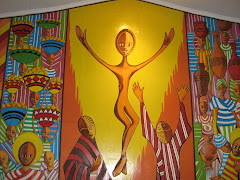
Contemplating the Tomb of Jesus
Question: The tomb where Jesus was buried... Where is it? What does it look like? Is there a picture of the tomb? Can you visit the burial site of Jesus?
It would be really nice if I could tell you that the photo below is of the tomb that Jesus once was laid in. Though this tomb, well outside of Jerusalem, serves as a great example of a first century burial place, that's all it is... a great example.
---------------------
Does it sound odd
to contemplate the tomb of Jesus?
Let me explain...
For several years now, whenever I make a retreat or give a retreat to others, I have found it very, very fruitful to enter into this contemplation or suggest it to others.
What does contemplation of the tomb really mean?
“Now there was a man named Joseph from the Jewish town of Arimathea. He was a member of the council, a good and righteous man, who had not consented to their purpose and deed, and he was looking for the kingdom of God. This man went to Pilate and asked for the body of Jesus. Then he took it down and wrapped it in a linen shroud, and laid him in a rock-hewn tomb, where no one had ever yet been laid. It was the day of Preparation, and the Sabbath was beginning. The women who had come with him from Galilee followed, and saw the tomb, and how his body was laid; then they returned, and prepared spices and ointments.
On the Sabbath they rested according to the commandment.”
Luke 23: 50-56
Taking this Gospel passage as the faith-history of the burial of the body of Jesus, you are invited to follow the vivid sequences in the narrative.
-I Take part in the burial of Jesus with lively sentiments just as I would take part in the funeral of one of my dear ones...
============
Having taken part in the burial of Jesus, spend sometime sitting at the tomb of Jesus with Joseph of Arimathea, the women and others. You may confidently imagine that Mother of Jesus is there too.
->Enter into a dialogue with any one of them or with all of them. Have a faith sharing on the mystery of Jesus’ life, passion, and cruel but redemptive death with a sense of wondering and trusting faith.
->Feel the emotions that emerge from within the depth of your heart.
->See that all the others have gone from the tomb with genuine sorrow ...
->Spend a few moments at the tomb with the body of Jesus in the tomb...
->Become aware of any unfinished business in my life that keeps showing up every now and then and crying for deliverance and healing...
->They can rightly be called ‘dead matter’ in us...
->Identify each dead matter and try to give it a name, e.g., suppressed anger, refusal to forgive, lack of reconciliation, jealousy, stubbornness, showiness, false justification, misunderstanding, lack of acceptance, destructive criticism of others, resistance to God’s Spirit, etc...
->I can give a decent funeral to all such experiences...
->Just imagine that I throw the “dead-matter” one by one into the tomb of Jesus...
->In fact, Jesus has already taken all my unfinished businesses into his passion and death and offered them to God. “It is finished.”
->My conscious acceptance of my negativities and throwing them into the tomb of Jesus will certainly liberate me into a redeemed person that I am called to be by my baptism.
->This is faith-sensitivity; and I can spend sometime/much time allowing my eyes of faith to wander at leisure into the inner feelings and movements that emerge...
-> A feeling of Time, space –> dissolving into mystery of God…!
-> The tomb of Jesus becoming a transit route/ a pathway to God’s
Mystery.…
-> An experience of all my “dead-matter” being purified and
transformed in Christ….
-> Our life is not written off, but written into the very heart of God’s own
life, love and compassion. So be it!
''''''''''''''''''''''''''''''vmalpan@gmail.com






